Travel Guide, Sapa
Sapa Weather By Month: A Guide to Sapa’s Varied Climates
Explore the ethereal landscapes of Sapa, Vietnam, where the weather dances in harmony with the lush mountain terrain. In our comprehensive travel guide, we unveil the nuances of Sapa weather by month, offering you insights into the dynamic climate that graces this enchanting destination. From the misty peaks to the vibrant valleys, understanding the seasonal variations is key to planning a perfect sojourn. Let’s embark on a journey through the changing seasons of Sapa, ensuring you’re well-prepared to embrace the beauty that each month brings.
Overview of Sapa weather
Geographical Location
Northwest Vietnam is home to the picturesque mountain town of Sapa, which is surrounded by incredibly gorgeous green valleys. This picturesque location is surrounded by rolling hills and rich flora in a mountainous landscape that will take your breath away. Due to its tropical environment, the area is a great choice for people looking to get away from crowded cities. Due to its unusual location, Sapa is higher up than the neighboring areas but still close enough to experience hot summer days. With these particular weather and landscapes, Sapa offers travelers something unique.
Humidity
Since humidity has a major impact on temperature and other weather factors, it is an essential component of Sapa’s climate. It speaks of the quantity of water vapor in the atmosphere, which can be determined by absolute moisture content, relative humidity, dew point temperature, and humidity levels or percentages.
With a mean value of 82%, July often has the highest monthly humidity level, while January typically sees the lowest, at roughly 73%. Because of the increasing rainfall, April through September typically experiences higher than usual humidity levels. But from October through March, these numbers often remain in the 70–75% range. Based on this information, one may assume that summertime visits to Sapa should be prepared for high levels of air moisture, which will result in more humid days. Bring clothing that is suitable for hot, humid conditions to better prepare for such climates.
Average Temperature
With an average yearly temperature of 17°C (62.6°F), Sapa, Vietnam enjoys a temperate environment. The month-by-month temperature range in Sapa is 10–22°C (50–71.6°F), with two different seasons: dry and wet.
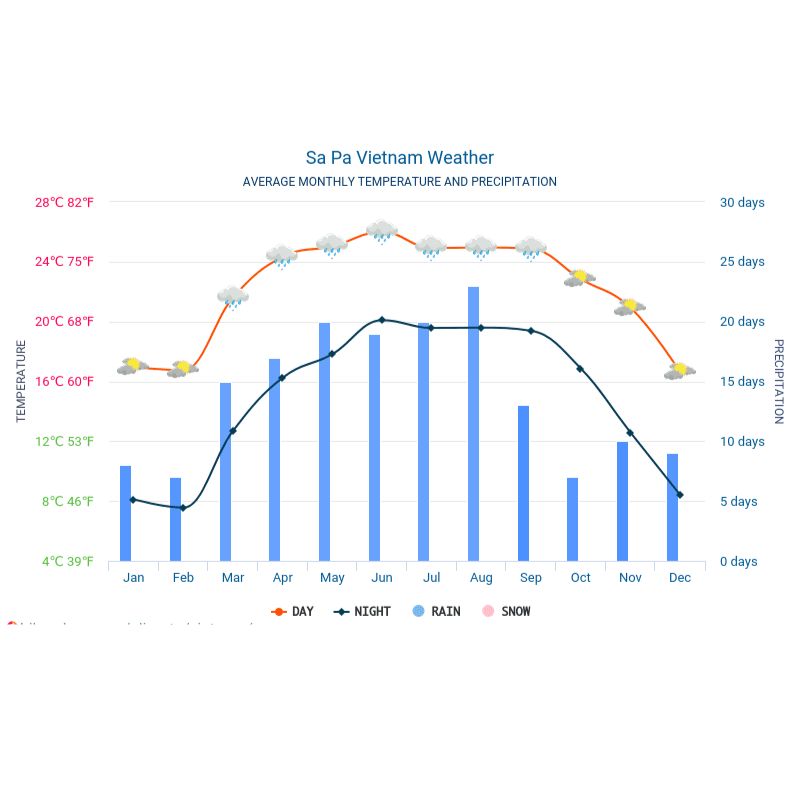
When it comes to average monthly temperatures, April is the warmest month with highs of 22°C (71.6 °F), while January is the coolest at 13°C (55.4 °F). The average temperature throughout those months is between 16 and 18°C (60.8 and 64.4 °F). Because of this, Sapa has one of Southeast Asia’s most agreeable year-round temperatures.
Because Sapa encounters low-pressure systems during both its rainy and dry seasons, which bring forth abrupt showers or clear days, respectively, the city’s weather can vary rapidly. It is therefore recommended that visitors pack for every eventuality that might occur when there.
Before exploring the typical rainfall patterns in this area, travelers to Sapa will know more about what to pack for their visit to this quaint city tucked away in the highlands of northern Vietnam thanks to this information about the city’s normal temperature.
Sunshine Hours Per Day
There are some places where you can have large amounts of sunshine every day of the year with minimal change in the seasons, such as the tropics or desert regions. Nevertheless, comparing statistics on sunshine duration month to month reveals that most locations see variations.
Measurements taken over some time are needed to determine the daily sunlight hours at a certain place. The average hourly sunshine totals may then be calculated using this data, providing us with a picture of the annual patterns in sunshine in our region. Having this knowledge enables us to plan appropriately for outdoor activities such as gardening and picnics.
Rainfall Patterns
The amount of precipitation in the Sapa region varies greatly from season to season and from month to month. Understanding rainfall patterns is essential for farmers, tourists, and locals to make wise decisions about crops and activities. To provide a clear picture, the following four observations are made:
- During the summer (June to August), there is 60–150 mm of rainfall.
- The highest monthly precipitation, up to 200 mm, occurs in October.
- The lowest monthly average of 30mm of annual rainfall occurs during the winter months of December through February.
- The wettest months are May and September when torrential downpours are caused by the arrival of rainy monsoon winds.
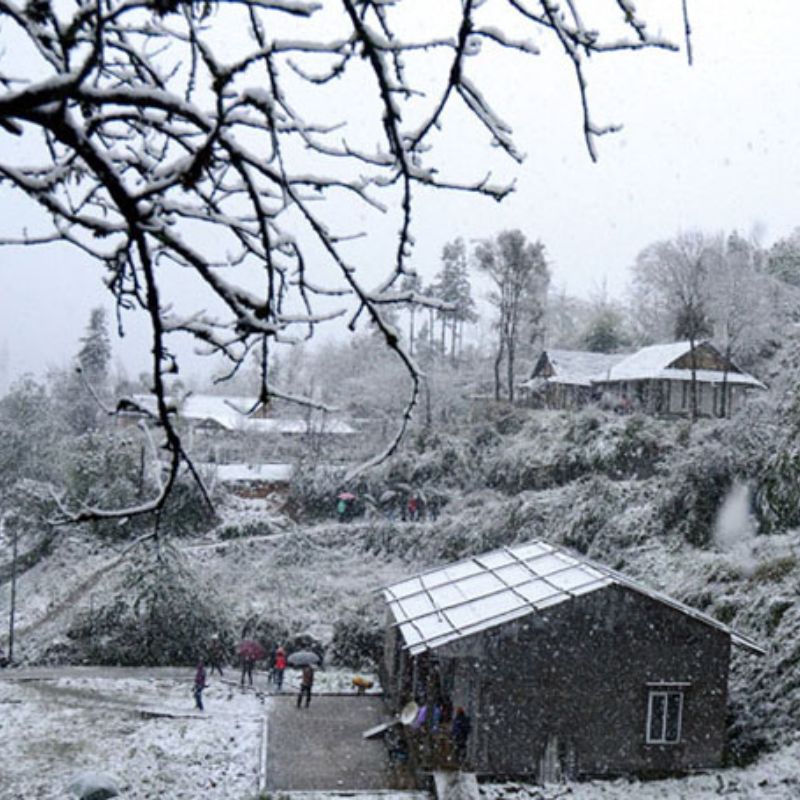
Wind Direction And Speed
When evaluating the Sapa weather by month, wind direction and speed are crucial aspects to take into account. This area has a wide range of wind patterns, from mild easterly breezes in the winter to stronger northwesterly gusts in the summer. The evening hours usually see stronger wind speeds, with occasional gusts of up to 15 knots. Depending on their strength and direction, winds can help maintain either a colder or warmer temperature.
Conditions for rainfall also primarily depend on the directions of the dominant winds. For instance, during the rainy season, northeasterly trade winds produce significant downpours, but southeasterly monsoon winds typically bring less rain. Furthermore, strong westerly winds that are frequently brought by cold fronts that pass through the region can result in substantial precipitation occurrences all year long.
Seasonal Factors
Throughout the year, Sapa undergoes a variety of seasonal fluctuations. The seasons with the biggest temperature swings are spring and fall when it can go from being warm to freezing in a matter of hours. Summertime highs in the mid-20s Celsius are common, with nightly lows of about 15 degrees Celsius. Winter temperatures are fairly low, rarely rising beyond 13 degrees Celsius during the day and as low as 0 degrees at night. Because Sapa is higher than the rest of Vietnam, it has low amounts of snowfall throughout the monsoon season, which lasts from June to August.
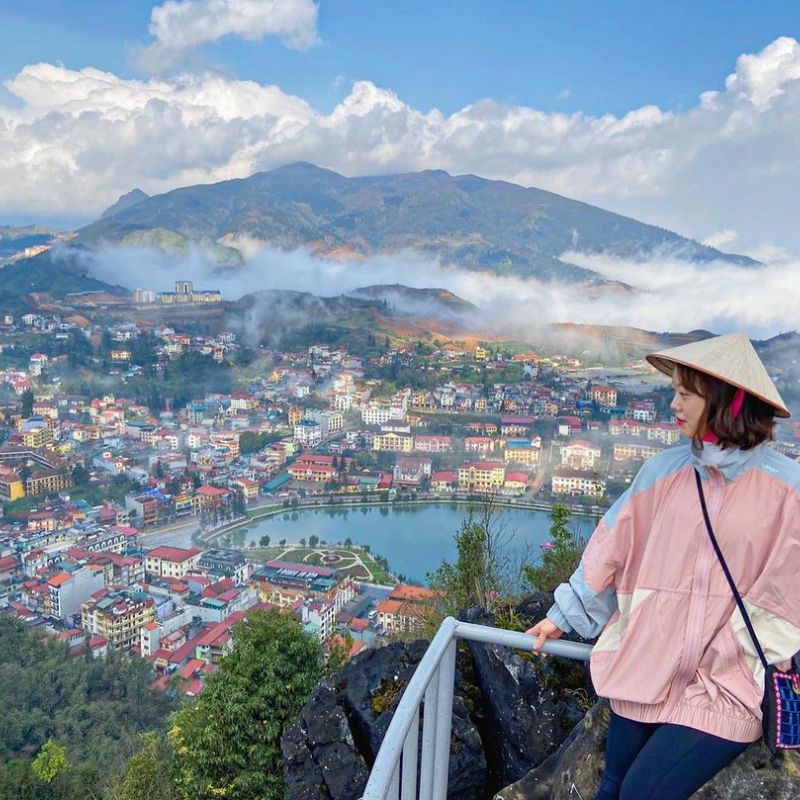
The amount of daylight varies significantly throughout the year as well, from 8 to 9 hours in the winter to 12 to 13 hours in the summer. When organizing your trip to Sapa, these things need to be taken into account, especially if you intend to participate in outdoor activities like hiking or trekking. Considering the aforementioned meteorological data, let us examine the recommended clothing items for your trip to Sapa.
When is the ideal time to travel to Sapa?
Sapa always has its unique seasonal beauty, whatever the time of year you visit. The average annual temperature in Sapa is between 15 and 18 degrees Celsius. It can plunge below zero degrees Celsius, especially in the winter, when there is a good chance of snowfall. If you want to see snow in Vietnam, one of the greatest places to go is Sapa.
Spring
Sapa’s springtime is breathtaking, with hundreds of flowers in bloom. when every hill and peak is covered in the floral hue of cherry, peach, or white plum blossoms. Here, too, springtime means a variety of floral festivals.
Summer
The most iconic image that comes to mind when one thinks of the Summer of Sapa is vast green terraced fields bathed in golden sunshine. Coming here during the summer allows you to experience all four seasons in a single day; it’s very magical. You will experience the warmth of Spring in the early morning, the intensity of Summer at noon, the gentle Autumn weather shortly after in the afternoon, and the chill of Winter in the evening.

Autumn
Sapa’s autumnal splendor is regarded as the marvel of both Vietnam and the Northwest area. The rice is ready and harvested during the Golden Season in late August and early September in Sapa. The season for harvesting highland rice arrives after months of hard effort in the months before. The season for harvesting highland rice arrives after months of hard effort in the months before.
Farmers welcome it with great enthusiasm because it only occurs once a year. You have the ingredients for the most exquisite holiday in the Northwest when you combine the aromatic scent of freshly made sticky rice with interactions with the locals who are excitedly working the fields in groups.
Winter
Have you ever seen flowers made of ice or snow? We seldom ever get to see it in Vietnam. However, Sapa is the only ideal location in Vietnam where we may witness that firsthand. That’s why a lot of winter celebrations are celebrated so brilliantly, such as Sunworld Winter Festive Day and Christmas & New Year.
Highlights of Sapa weather by month and top activities
The month-by-month weather in Sapa provides a diverse range of experiences all year round.
January
With an average daily temperature of less than 10°C, Sapa is the second-coldest month of January. Visitors should anticipate around 23 millimeters of rainfall during the month, which is far less than at other periods of the year.
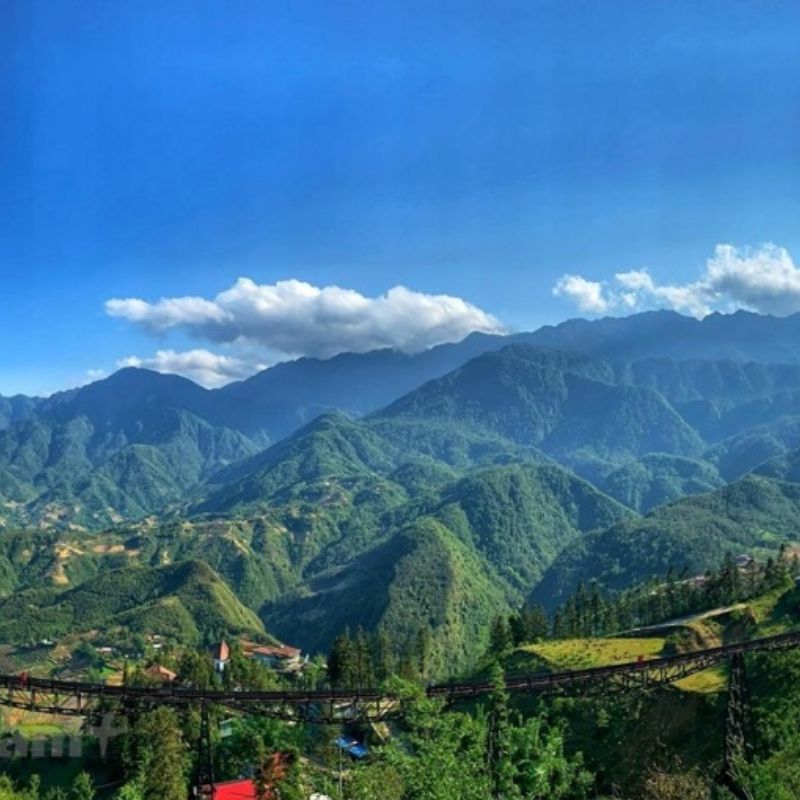
A visit to Cat Cat Village is one of the many activities that Sapa has to offer for those looking for things to do in Sapa. This charming village is well-known for its stunning scenery and distinctive cultural customs. Since January is the off-peak month, there are fewer tourists and it’s easy to get affordable lodging.
February
The average yearly temperature in Sapa is between 8 and 14°C. At this time of year, fog and mist are typical. In actuality, the weather gets warmer toward the conclusion of the month. On cool days, low temperatures and high humidity normally do not cause pain, even though high humidity is typically greater than 82%.
Hiking is particularly enjoyable in February, but as always, check the local forecast to make sure it’s safe to spend the entire day outside. Occasionally, a few of the younger kids could approach you to make sales demands. They may accompany you on the trekking trail, but they are by no means innocuous, so please do not worry about them. If you do not intend to buy, you are free to decline this offer and continue on your way without any concerns.
March
In Sapa, the daily average temperature in March is approximately 15°C. During this time of year, the weather in the area is frequently very variable, offering glimpses of four distinct seasons in one day.
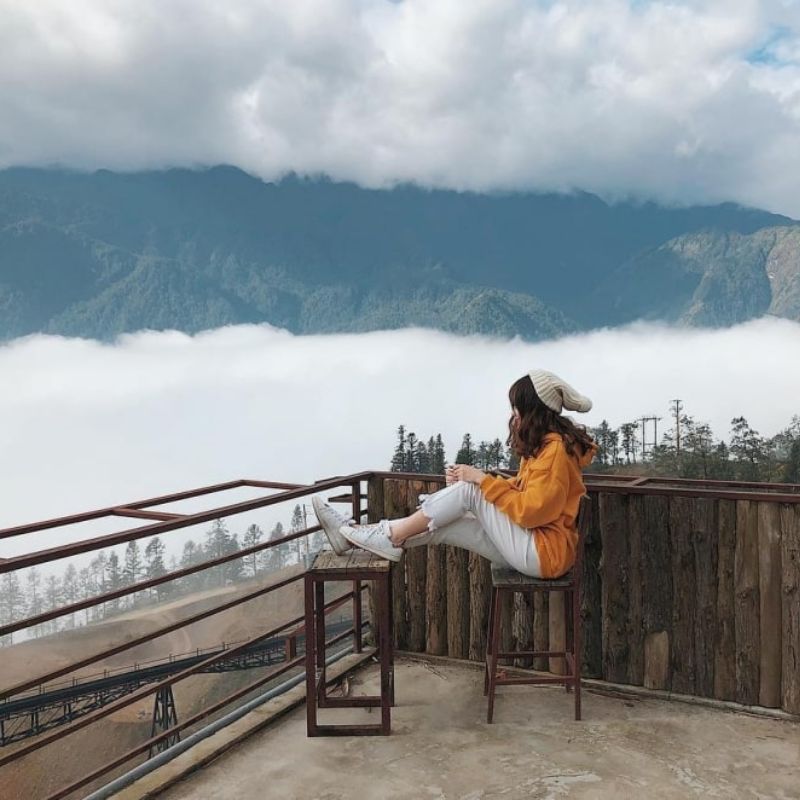
March is a great month to explore the outdoors because of the weather, which is perfect for things like cycling, trekking in Sapa, and soaking in the landscape. Trekkers are drawn to the Sapa mountain range, and those seeking a truly challenging experience might want to tackle Fansipan Mountain, the highest peak in all of Indochina. Since a lot of people will be visiting this area during this period, booking accommodations in advance is essential for a hassle-free visit.
April
When visiting Sapa in April, be sure to include sightseeing in the stunning Muong Hoa Valley, which is considered the pride of Sapa. One should also take the opportunity to explore Sapa’s natural beauty. Among these are the Tram Ton Pass and the Thac Bac Waterfall. The weather in Sapa is unique in April, both during the day and at night. It is possible for the daytime temperatures to be extremely hot and the nighttime temperatures to be extremely cold. Thus, keep that in mind and dress appropriately.
May
Sapa welcomes the first few months of summer with clear skies at this time. The average temperature in Sapa in May is between 16 and 24°C. Nonetheless, the evenings and nights are often colder, with temperatures between 15 and 17°C.
Right now, you can spend your time in Ta Phin Village. To get a taste of country life, you can stay at a homestay, stay at the Ta Phin Ancient Monastery, or reside at the home of an ethnic minority. Summer vacation officially begins in May, and many students take to the streets to sell a variety of goods. It is best not to buy anything from these kids because if their parents see them working and earning money, the kids can feel pressured to keep working rather than go back to school when the next semester starts.
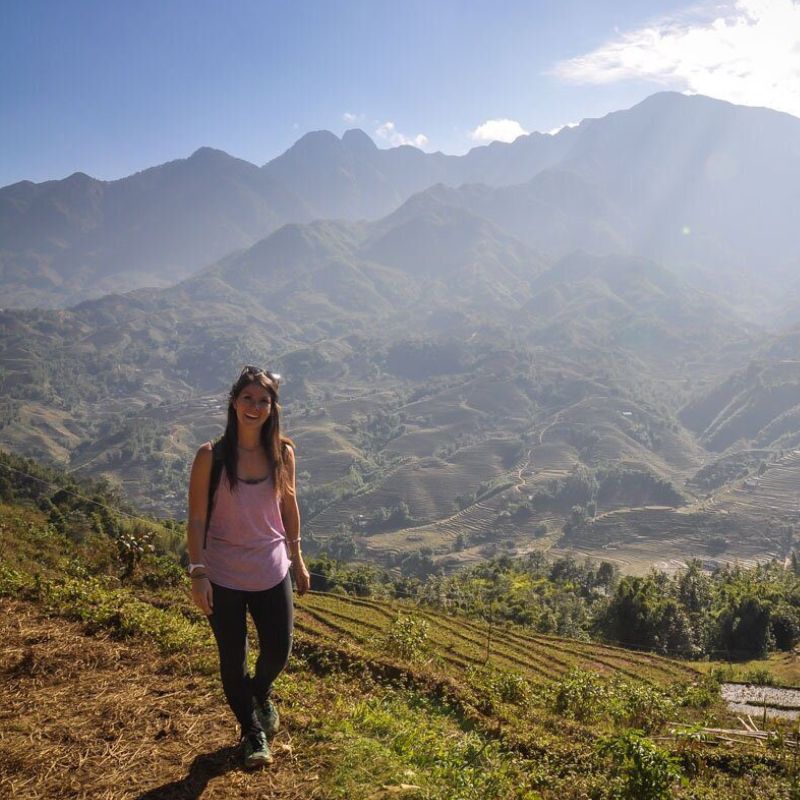
June
The weather in Sapa is still pleasant in June, although there is more rainfall than in May and up to 81% humidity. With an average temperature of about 21°C, it is rather similar to May.
In Sapa, the plum-picking season begins in June. Thus, don’t pass up the chance to enjoy the delight of choosing plums straight from the orchard. The majority of Sapa’s plum orchards are located on the road leading up to O Quy Ho Pass. It is advised that you stay in Sapa for at least three days and two nights if you intend to come in June. This will give you plenty of time to take in the breathtaking scenery and leave time for inclement weather.
July
With temperatures ranging from 18°C to 24°C in July, Sapa is a great destination for people looking to escape the summer heat. In July, there are also sporadic showers in Sapa. In addition, the temperature at night is generally chilly during this time of year, with lows around 10°C.
July’s golden sunshine peeks through the swaying clouds every now and then, bathing the verdant rice fields of Sapa in a brilliant glow. Additionally, Sapa is home to a plethora of festivals and events that provide you with the chance to learn about what’s coming up when you arrive and take part in them.
August
Sapa experiences an average high of about 20°C in August, however, nights bring a noticeable dip in temperature, usually to around 10°C. In addition, travelers should anticipate 23 days of rain.
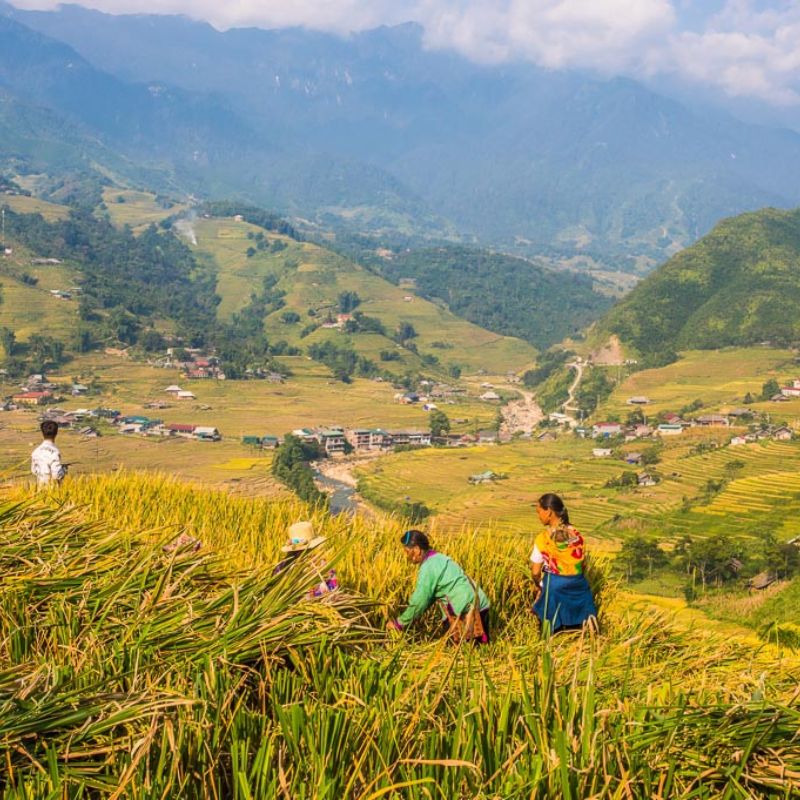
You can ride a bike, go climbing, or just stroll about the town’s streets. You can also stop by a few stores to pick up gifts or strike up a conversation with the residents to find out about their everyday routines. Because Sapa is known for its breathtaking scenery, make sure to bring along a camera, a camcorder, or at least your smartphone to capture the moment.
September
The temperature can reach up to 24°C during the day and drops to approximately 11°C at night. Elevated temperatures, an abundance of sunlight, and generally agreeable weather make May a perfect month for outdoor pursuits. It makes sense to suppose that September saw more precipitation than previous months given Sapa’s steep geography.
October
October in Sapa brings pleasant temperatures with bright days, cold nights, and clear blue skies. The temperature fluctuates from 13°C to 25°C at its highest point. During this time, Sapa’s humidity can reach a maximum of 82%.
Trekking is by far the best way to explore Sapa, especially in October. You can unwind and decompress with a Sapa massage after your climb. Use bug repellent to avoid irritating bites or potential infections that these creatures, especially leeches, may carry. Mosquitoes and leeches are abundant.
November
November weather in Sapa is thought to be nice and comfortable, with clear, dry skies and little rain. In November, the average daily temperature in Sapa is between 14°C and 17°C, with a maximum humidity of 82%.
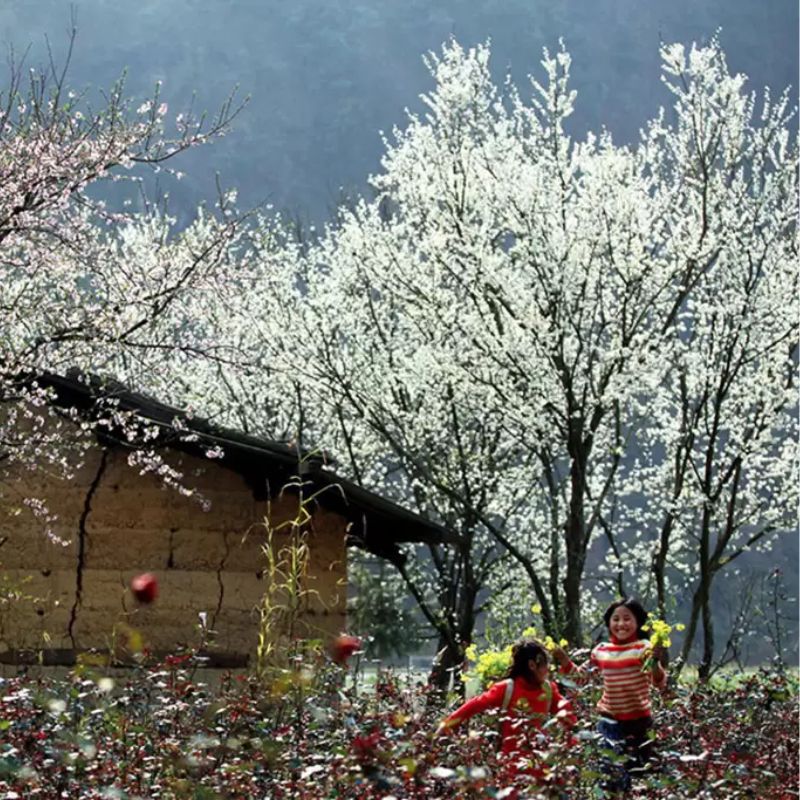
The season for cloud hunting in Sapa begins in November, providing a chance to photograph the region’s enthralling cloud formations. The ecotourism area of Ham Rong Mountain is a notable destination for cloud hunting. It’s important to take warm clothes, such as coats, scarves, and gloves, as the temperature can drop significantly.
December
December could have extremely frigid weather because it falls in the middle of winter. The typical temperature is between 8°C and 10°C, with occasional lows of 0°C throughout the night. Together with January, December is one of the driest months in Sapa due to its very low amount of precipitation.
Travelers at this time of year can take advantage of the Sapa Winter Festival. Numerous parades and performances highlight the beauty of the unique cultural clothing worn by different ethnic groups during this festival. Since this is Sapa’s off-peak season, hotels and tourist attractions won’t be crowded, and you’ll receive excellent treatment.
The diverse tapestry of Sapa weather by month, we hope this guide has provided you with the tools to confidently plan your visit. Whether you seek the bloom of spring, the vibrancy of summer, the harvest hues of autumn, or the serene landscapes of winter, Sapa welcomes you with open arms throughout the year. Each month unveils a unique facet of this Northern Vietnamese gem, ensuring that, no matter when you arrive, Sapa’s breathtaking beauty will captivate your heart and leave you with memories that linger like the mists over its rolling hills.
FAQs
How cold does it get in Sapa during the winter months?
During the winter months in Sapa, which typically span from December to February, temperatures can become quite chilly. The mercury often hovers between 5 to 10 degrees Celsius (41 to 50 degrees Fahrenheit), bringing a noticeable drop in temperature. While snowfall is infrequent, the air carries a crisp and refreshing bite. Travelers planning a winter visit to Sapa should be prepared for cooler weather, packing layers, jackets, and other warm clothing to stay comfortable, especially during the cooler evenings and early mornings when temperatures can be at their lowest.
Does it rain a lot during the summer in Sapa?
Yes, the summer months in Sapa, which typically span from June to August, experience a significant amount of rainfall. The monsoon season brings frequent and sometimes heavy rains, contributing to the lush greenery of the surrounding landscapes. The rainfall can lead to slippery and muddy trails, so visitors should be prepared for wet conditions if planning outdoor activities during this time. Travelers should consider bringing waterproof gear and plan their activities accordingly to make the most of their visit during the summer season in Sapa.
Are there specific months for trekking in Sapa?
Yes, there are specific months that are ideal for trekking in Sapa. The best trekking conditions in Sapa are typically during the spring (March to May) and fall (September to November). During these months, the weather is relatively mild, and the landscapes are vibrant. The temperatures are comfortable for trekking, and the scenery is at its most picturesque, with blooming flowers in spring and the terraced rice fields lush and green in the fall.
Is it advisable to visit Sapa during the Lunar New Year (Tet) in January or February?
While visiting Sapa during the Lunar New Year, known as Tet in Vietnam, can offer a unique cultural experience, there are certain considerations to keep in mind. Tet is a significant celebration, and many locals return to their hometowns to celebrate with family. Consequently, some services, businesses, and attractions may be closed or operate for limited hours during this period.
While you can witness traditional festivities and celebrations, it’s essential to plan accordingly and be aware that transportation may be crowded as people travel to be with their families. If you’re looking for a quieter and more relaxed visit to explore Sapa’s attractions and local life, it might be advisable to choose a different time to visit. However, if you are interested in experiencing the cultural richness and festive spirit of Tet, Sapa can offer a distinctive perspective during this time of celebration.
Can I see the terraced rice fields in Sapa during a particular season?
Yes, the terraced rice fields in Sapa exhibit their most vibrant and picturesque views during specific seasons. The best times to witness the stunning beauty of the terraced rice fields are late spring, particularly in May, and during the harvest season in September.
In late spring, the terraced fields are lush green as the young rice plants start to thrive. The landscape becomes a patchwork of vibrant greenery, creating a visually striking scene. Additionally, May is when many flowers, including peach blossoms and plum blossoms, bloom, adding more colors to the picturesque scenery.
During the harvest season in September, the terraced rice fields transform into a sea of golden hues as the rice ripens and is ready for harvesting. The golden fields against the backdrop of the surrounding mountains create a mesmerizing and iconic landscape, making it another excellent time to visit Sapa for those seeking the beauty of the terraced rice fields.

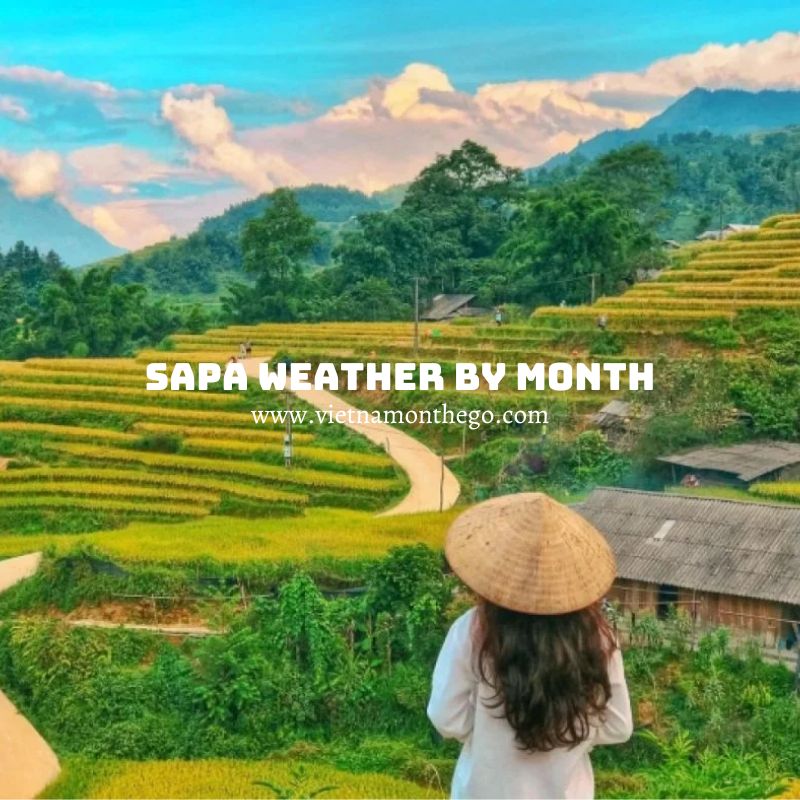
![[1 DAY] Trekking in Sapa Through Muong Hoa Valley - EASY Route](https://vietnamonthego.com/wp-content/uploads/2023/12/Trekking-in-Sapa-Through-Muong-Hoa-Valley-2-280x280.jpg)
![[1 DAY] Trekking in Sapa Through Highest Village](https://vietnamonthego.com/wp-content/uploads/2023/12/fansipan-hiking-tour-1-day-3-280x280.jpg)
![[1 DAY] Trekking In Sapa Through Muong Hoa Valley - HARD Route](https://vietnamonthego.com/wp-content/uploads/2023/12/Muong-Hoa-Valley-280x280.jpg)
![[2 DAYS 1 NIGHT] Sapa Trekking Tour with Local Guide](https://vietnamonthego.com/wp-content/uploads/2023/12/Sapa-Trekking-Tour-with-Local-Guide-9-280x280.jpg)
![[2 DAYS 1 NIGHT] Sapa Trekking with Homestay in Village - EASY Trekking](https://vietnamonthego.com/wp-content/uploads/2023/12/fansipan-hiking-tour-1-day-5-280x280.jpg)
![[1 DAY] Fansipan Hiking Tour From Sapa with Local Expert fansipan hiking 1 day tour](https://vietnamonthego.com/wp-content/uploads/2023/12/fansipan-hiking-tour-1-day-280x280.jpg)
![[2 DAYS 1 NIGHT] Fansipan Mountain Hiking From Sapa Fanispan hiking 2d1n tour](https://vietnamonthego.com/wp-content/uploads/2023/12/fansipan-hiking-tour-2-1-280x280.jpg)